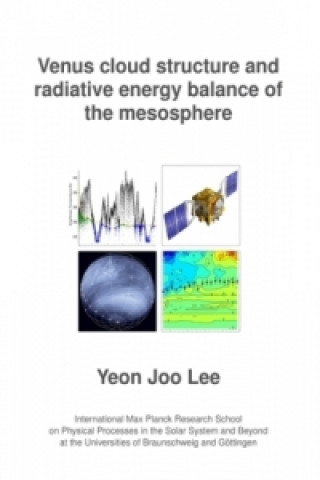
Code: 01948439
Venus Cloud Structure and Radiative Energy Balance of the Mesosphere
by Yeon Joo Lee
A dense cloud layer located at 5075 km altitude completely covers Venus. The cloud aerosol consists mainly of sulfuric acid mixed with still unknown constituents. Due to their great opacity, the clouds play an important role in th ... more
- Language:
 English
English - Binding: Paperback
- Number of pages: 150
Publisher: uni-edition, 2012
- More about this

You might also like
-

Dune
35.33 zł -33 % -

Haunting Adeline
125.29 zł -2 % -

Berserk Deluxe Volume 2
214.34 zł -1 % -

White Nights
15.53 zł -23 % -

Powerless
44.97 zł -13 % -

Atomic Habits
78.68 zł -19 % -

Dune Messiah
46.70 zł -3 % -

Berserk Deluxe Volume 3
221.96 zł -

One Day
32.89 zł -36 % -

Berserk Deluxe Volume 1
213.53 zł -2 % -

Iron Flame
61.62 zł -28 % -

Surrounded by Idiots
52.38 zł -23 % -

Harry Potter and the Prisoner of Azkaban (Minalima Edition)
171.80 zł -2 % -

Gravity Falls Journal 3
89.75 zł -1 % -

Heaven Official's Blessing: Tian Guan Ci Fu (Novel) Vol. 1
89.75 zł -1 % -

The Creative Act
101.02 zł -15 % -

Dune
38.37 zł -38 % -

Hunting Adeline
131.18 zł -1 % -

A Little Life
48.93 zł -12 % -

Children of Dune
47.11 zł -2 % -

Heaven Official's Blessing: Tian Guan Ci Fu (Novel) Vol. 2
96.55 zł
Availability alert
Enter your e-mail address and once book will be available,
we will send you a message. It's that simple.
More about Venus Cloud Structure and Radiative Energy Balance of the Mesosphere
 Book synopsis
Book synopsis
A dense cloud layer located at 5075 km altitude completely covers Venus. The cloud aerosol consists mainly of sulfuric acid mixed with still unknown constituents. Due to their great opacity, the clouds play an important role in the radiative energy balance, the general circulation, and the atmospheric chemistry. The knowledge about the upper part of the clouds is especially important to understand the Venus mesosphere, because it is responsible for thermal cooling and solar heating that eventually results in the strongest retrograde zonal wind near the cloud tops in all altitudes. Remote observations have indicated significant temporal and spatial variations of the cloud structure that should affect radiative energy balance of the mesosphere. This thesis investigates the upper cloud layer of Venus. Firstly, the vertical structure of the upper clouds and its variation with latitude are retrieved from the Venus Express observations. For this purpose, we have developed a new technique which uses temperature profiles from the radio science occultation experiment VeRa and thermal emission spectra in the 4.45.0 m range collected by thermal infrared spectrometer VIRTIS. We implemented a comprehensive radiative transfer code including line-by-line calculations of gaseous opacities, and taking account for multiple scattering of aerosols. This study shows significant latitudinal trends in the upper cloud structure. Secondly, we investigated the influence of clouds, and their variability on the thermal fluxes and cooling rates calculated in a broad spectral range (3.86200 m). We developed and used an atmospheric model based on the derived parameters of the upper cloud and the observed temperature field. The result, thermal cooling rates, is compared with the solar heating rates to derive the radiative energy balance.
 Book details
Book details
- Full title: Venus Cloud Structure and Radiative Energy Balance of the Mesosphere
- Author: Yeon Joo Lee
- Language:
 English
English - Binding: Paperback
- Number of pages: 150
- EAN: 9783942171687
- ISBN: 3942171686
- ID: 01948439
- Publisher: uni-edition
- Weight: 250 g
- Dimensions: 209 × 152 × 8 mm
- Date of publishing: 03. September 2012
safisfied customers
Since 2008, we have served long line of book lovers, but each of them was always on the first place.
Copyright! ©2008-24 libristo.pl All rights reservedPrivacyPoučení o cookies



 21 million books
21 million books Delivery 12.99 zł
Delivery 12.99 zł (32) 444 93 66 (8-15.30h)
(32) 444 93 66 (8-15.30h)